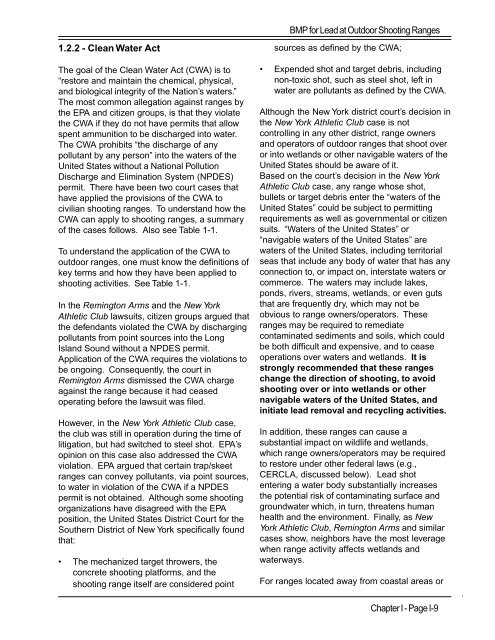Chapter I: Environmental and Regulatory Concerns at the Shooting ...
Chapter I: Environmental and Regulatory Concerns at the Shooting ...
Chapter I: Environmental and Regulatory Concerns at the Shooting ...
Create successful ePaper yourself
Turn your PDF publications into a flip-book with our unique Google optimized e-Paper software.
BMP for Lead <strong>at</strong> Outdoor <strong>Shooting</strong> Ranges1.2.2 - Clean W<strong>at</strong>er ActThe goal of <strong>the</strong> Clean W<strong>at</strong>er Act (CWA) is to“restore <strong>and</strong> maintain <strong>the</strong> chemical, physical,<strong>and</strong> biological integrity of <strong>the</strong> N<strong>at</strong>ion’s w<strong>at</strong>ers.”The most common alleg<strong>at</strong>ion against ranges by<strong>the</strong> EPA <strong>and</strong> citizen groups, is th<strong>at</strong> <strong>the</strong>y viol<strong>at</strong>e<strong>the</strong> CWA if <strong>the</strong>y do not have permits th<strong>at</strong> allowspent ammunition to be discharged into w<strong>at</strong>er.The CWA prohibits “<strong>the</strong> discharge of anypollutant by any person” into <strong>the</strong> w<strong>at</strong>ers of <strong>the</strong>United St<strong>at</strong>es without a N<strong>at</strong>ional PollutionDischarge <strong>and</strong> Elimin<strong>at</strong>ion System (NPDES)permit. There have been two court cases th<strong>at</strong>have applied <strong>the</strong> provisions of <strong>the</strong> CWA tocivilian shooting ranges. To underst<strong>and</strong> how <strong>the</strong>CWA can apply to shooting ranges, a summaryof <strong>the</strong> cases follows. Also see Table 1-1.To underst<strong>and</strong> <strong>the</strong> applic<strong>at</strong>ion of <strong>the</strong> CWA tooutdoor ranges, one must know <strong>the</strong> definitions ofkey terms <strong>and</strong> how <strong>the</strong>y have been applied toshooting activities. See Table 1-1.In <strong>the</strong> Remington Arms <strong>and</strong> <strong>the</strong> New YorkAthletic Club lawsuits, citizen groups argued th<strong>at</strong><strong>the</strong> defendants viol<strong>at</strong>ed <strong>the</strong> CWA by dischargingpollutants from point sources into <strong>the</strong> LongIsl<strong>and</strong> Sound without a NPDES permit.Applic<strong>at</strong>ion of <strong>the</strong> CWA requires <strong>the</strong> viol<strong>at</strong>ions tobe ongoing. Consequently, <strong>the</strong> court inRemington Arms dismissed <strong>the</strong> CWA chargeagainst <strong>the</strong> range because it had ceasedoper<strong>at</strong>ing before <strong>the</strong> lawsuit was filed.However, in <strong>the</strong> New York Athletic Club case,<strong>the</strong> club was still in oper<strong>at</strong>ion during <strong>the</strong> time oflitig<strong>at</strong>ion, but had switched to steel shot. EPA’sopinion on this case also addressed <strong>the</strong> CWAviol<strong>at</strong>ion. EPA argued th<strong>at</strong> certain trap/skeetranges can convey pollutants, via point sources,to w<strong>at</strong>er in viol<strong>at</strong>ion of <strong>the</strong> CWA if a NPDESpermit is not obtained. Although some shootingorganiz<strong>at</strong>ions have disagreed with <strong>the</strong> EPAposition, <strong>the</strong> United St<strong>at</strong>es District Court for <strong>the</strong>Sou<strong>the</strong>rn District of New York specifically foundth<strong>at</strong>:• The mechanized target throwers, <strong>the</strong>concrete shooting pl<strong>at</strong>forms, <strong>and</strong> <strong>the</strong>shooting range itself are considered pointsources as defined by <strong>the</strong> CWA;• Expended shot <strong>and</strong> target debris, includingnon-toxic shot, such as steel shot, left inw<strong>at</strong>er are pollutants as defined by <strong>the</strong> CWA.Although <strong>the</strong> New York district court’s decision in<strong>the</strong> New York Athletic Club case is notcontrolling in any o<strong>the</strong>r district, range owners<strong>and</strong> oper<strong>at</strong>ors of outdoor ranges th<strong>at</strong> shoot overor into wetl<strong>and</strong>s or o<strong>the</strong>r navigable w<strong>at</strong>ers of <strong>the</strong>United St<strong>at</strong>es should be aware of it.Based on <strong>the</strong> court’s decision in <strong>the</strong> New YorkAthletic Club case, any range whose shot,bullets or target debris enter <strong>the</strong> “w<strong>at</strong>ers of <strong>the</strong>United St<strong>at</strong>es” could be subject to permittingrequirements as well as governmental or citizensuits. “W<strong>at</strong>ers of <strong>the</strong> United St<strong>at</strong>es” or“navigable w<strong>at</strong>ers of <strong>the</strong> United St<strong>at</strong>es” arew<strong>at</strong>ers of <strong>the</strong> United St<strong>at</strong>es, including territorialseas th<strong>at</strong> include any body of w<strong>at</strong>er th<strong>at</strong> has anyconnection to, or impact on, interst<strong>at</strong>e w<strong>at</strong>ers orcommerce. The w<strong>at</strong>ers may include lakes,ponds, rivers, streams, wetl<strong>and</strong>s, or even gutsth<strong>at</strong> are frequently dry, which may not beobvious to range owners/oper<strong>at</strong>ors. Theseranges may be required to remedi<strong>at</strong>econtamin<strong>at</strong>ed sediments <strong>and</strong> soils, which couldbe both difficult <strong>and</strong> expensive, <strong>and</strong> to ceaseoper<strong>at</strong>ions over w<strong>at</strong>ers <strong>and</strong> wetl<strong>and</strong>s. It isstrongly recommended th<strong>at</strong> <strong>the</strong>se rangeschange <strong>the</strong> direction of shooting, to avoidshooting over or into wetl<strong>and</strong>s or o<strong>the</strong>rnavigable w<strong>at</strong>ers of <strong>the</strong> United St<strong>at</strong>es, <strong>and</strong>initi<strong>at</strong>e lead removal <strong>and</strong> recycling activities.In addition, <strong>the</strong>se ranges can cause asubstantial impact on wildlife <strong>and</strong> wetl<strong>and</strong>s,which range owners/oper<strong>at</strong>ors may be requiredto restore under o<strong>the</strong>r federal laws (e.g.,CERCLA, discussed below). Lead shotentering a w<strong>at</strong>er body substantially increases<strong>the</strong> potential risk of contamin<strong>at</strong>ing surface <strong>and</strong>groundw<strong>at</strong>er which, in turn, thre<strong>at</strong>ens humanhealth <strong>and</strong> <strong>the</strong> environment. Finally, as NewYork Athletic Club, Remington Arms <strong>and</strong> similarcases show, neighbors have <strong>the</strong> most leveragewhen range activity affects wetl<strong>and</strong>s <strong>and</strong>w<strong>at</strong>erways.For ranges loc<strong>at</strong>ed away from coastal areas or<strong>Chapter</strong> I - Page I-9
















